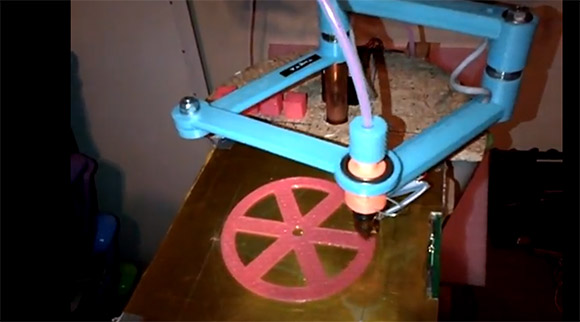
Here’s a neat alternative to the usual gantry setup you see on 3D printers. [Quentin] designed and build a SCARA arm 3D printer that just saw its first print.
We caught wind of [Quentin]’s SCARA arm a few weeks ago when it was still just a few plastic parts and a glimmer of ambition in its creator’s eye. Most of the parts are 3D printed, including the blue arms for the x and y axes that are driven by stepper motors. The z axis is controlled by two lead screws, and judging by the height of [Quentin]’s machine, he has a pretty big printable volume – at least as large as some of the delta bot 3D printers we’ve seen.
So far [Quentin] has printed a handful of calibration cubes and a wheel with a fairly impressive print resolution. You can check out a video of the SCARA arm printer after the break.
[youtube=http://www.youtube.com/watch?v=oSmo7iZ10Bk&w=580]
















WOW!
When the camera moved to under the table, I was blown away, this build is awesome!
This machine is pretty silent, can you guys tell me how other printers compare?
Compared the Ultimaker printing in front of me, kinda sounds the same.
Great work! All the naysayers should apologize now.
Nice job with an impressive build.
It is a great idea, but your reproducability must go down the further the print head is from the supporting shaft. If the supprting arms are printed from ABS there must be a fair amount of flex. Does the print head dip as it is exended further from the support pilar? How is the stability of the arm at full extension?
I am honestly not trying to be critical. I just want to understand the tradeoffs with this aproach.
A second pair of arms could be mounted on the other side, and just driven in inverse.
I don’t think it would matter if the arm is fully extended or not. When it extends its not like there is more of the arms un-supported they are just further out. The arms don’t change length, they just change position. I really suck at explaining stuff…
It would matter – the load is moving further away from the support, increasing the leverage.
Great work. But is it really a SCARA arm if the Z axis isn’t built into the arm? Technically SCARAs are 3 DOF and this arm is just 2. Either way it’s a great idea!
It is 3 DOF if you consider the relationship if the arms to the tool surface. Some scara systems moves the tools, and others move the whole arm up and down. I simply took to move the tool surface. Still SCARA
SCARA stands for Selective Compliant Assembly Robot Arm, they were invented by Sankyo Seiki in the 80’s. A SCARA is an arm that has two revolute joints (X-Y) followed by a prismatic joint (Z). All joint axises are parellel to each other. There is a specific definition of a SCARA, this is not a SCARA, it is a 2DOF arm and a moving surface.
isnt it a parallel manipulator?
lol wut?
Oh, I see what you were asking. I think the additional linkages are idle and only there for support.
I fail to see the design improvement over traditional rep-rap devices.
I doubt it that this shape would allow for more detail
And overall their detail wouldnt be equal in all direction
So one might wonder what is the improvement here (if there is any)
I figured the improvement is in versatility. You could have a robot arm that’s also a 3D printer.
the improvements are huge, the X and Y axis are free from smooth roods and linear bearings, this is maybe the advanced reprap in therms of self reproducing
You can potentially create a far deeper/taller object than a normal reprap machine. If you increase the length of the lead screws and supports you could go as large as you want.
This is so rad. You could have a few of them all working on different sides of the same piece at the same time–many hands make light work. Or it could “easily” do multiple different filaments. Well done. :)
That is a very interesting and inspiring argument…! :)
Congrats! This methods allows big 3d models! I like the “scara” idea…
The mechanical complexity of this is many magnitudes lower than a traditional liner axis printer. this would be a great simper rep strap for new comers to 3D printing like me this. This seams a lot simpler for me to build in wood or steal.
Also this could print over a huge round area not just a small square. replacing the square bed with a circular z bead could allow the manufacture of round objects.
Definitely a nice design, I can see applications for odd-sized or -shaped parts. If you had a bed that surrounded the Z-axis you could print fairly large objects (with a donut hole).
It does look like it might be an easier build for first timers. For a given price point, however, I think the design is not as robust as a conventional 3d printer. In a conventional design with parallel rods and linear bearings, slop is limited to one degree of freedom. You can generally dial in the accuracy of each axis independently.
With this design, any slop in the bearings/bushings of the joints necessarily affects all three axes.The moment of the arm assembly also will affect 3-axis positional accuracy as the distance from the Z axis increases or the Z height increases, limiting practical part size. Finally, the X,Y resolution would also decrease as the distance from the Z axis increases (how many arcseconds of slop is in the rotation of the arm about the Z axis?). For small parts, this all may be negligible, but the design of this really screams for making large parts…
Scara ARM combined with 3Doodler could make an inexpensive easy to make rep rap